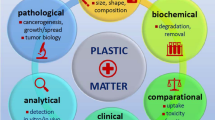Abstract
Polychlorinated biphenyls (PCBs) in maternal blood, milk, placenta, and cord blood were examined by gas chromatography (ECD-GC) and mass spectrometry (GC-MS). A significant linear correlation was found between the placental content of PCBs and that of the maternal blood and the milk. The greater the chlorine content of the PCB congeners, the more significant was this correlation. These phenomena may be due to the different lipophilic nature of each PCB congener. The placental transport of PCBs of the maternal blood to the cord blood is also different among PCB congeners. The analysis of the placenta and the cord blood for PCB is of value in estimating PCBs contamination in pregnant women and its transfer from the mother to the fetus.
Similar content being viewed by others
References
Ando M (1978) Transfer of 2,4,5,2′,4′,5′-hexachlorobiphenyl and 2,2-bis(p-chlorophenyl) 1,1,1-trichloroethane(p,p′-DDT) from maternal to newborn and suckling rat. Arch Toxicol 41:179–186
Chen PH, Chang KT, Lu YD (1981) Polychlorinated biphenyls and polychlorinated dibenzofurans in the toxic rice bran oil that caused PCB poisoning in Taichung. Bull Environ Contam Toxicol 26:489–495
Chu CK, Stella VJ, Bruckner JV, Jiang WD (1977) Effects of long term exposure to environmental levels of polychlorinated biphenyls on pharmacokinetics of pentobarbital in rats. J Pharmaceut Sci 66:238–241
Curley A, Copeland MF, Kimbrough RD (1969) Chlorinated hydrocarbon insecticides in organs of stillborn and blood newborn babies. Arch Environ Health 19:628–632
Folch J, Lees M, Sloane-Stanley, GH (1951) A simple method for the isolation and purification of total lipids from animal tissues. J Biol Chem 226:497–509
Jensen S, Sundström G (1974) Structures and levels of most chlorobiphenyls in two technical PCB products and in human adipose tissue. AMBIO 3:70–76
Kodama H, Ota H (1980) Transfer of polychlorinated biphenyls to infants from their mothers. Arch Environ Health 35:95–100
Kuratsune M, Yoshimura T, Matsuzaka J, Yamaguchi A (1972) Epidemiologic study on Yusho, a poisoning caused by ingestion of rice oil contaminated with a commercial brand of polychlorinated biphenyls. Environ Health Persp Experiment Issue 1:119–128
Masuda Y, Kagawa R, Kuroki H, Kuratsune M, Yoshimura T, Taki I, Kusuda M, Yamashita F, Hayashi M (1978) Transfer of polychlorinated biphenyls from mothers to fetuses and infants. Fd Cosmet Toxicol 16:543–546
Mes J, Doyle JA, Adams BR, Davies DJ, Turton D (1984) Polychlorinated biphenyls and organochlorine pesticides in milk and blood of Canadian women during lactation. Arch Environ Contam Toxicol 13:217–223
Nakamura A, Kashimoto T (1977) Studies on a calculation method for polychlorinated biphenyls (PCBs) isomers. J Food Hyg Soc Japan 18:1–12
Orberg J (1977) Placental and mammary transfer of two PCBs (2,4′,5-TCB and 2,2′,4,4′,5,5′-HCB) and their effect on reproductive capacity in mice. AMBIO 6:278–280
Parkinson A, Robertson L, Safe L, Safe S (1980) Polychlorinated biphenyls as inducers of hepatic microsomal enzymes: structure activity rules. Chem-Biol Interactions 30:271–285
Siddiqui MKJ, Saxena MC, Bhargava AK, Seth TD, Krishna Murti CR, and Kutty D (1981) Agrochemicals in the maternal blood, milk, and cord blood: a source of toxicants for prenates and neonates. Environ Res 24:24–32
Taki I, Hisanaga S, Nagase Y (1969) Report of Yusho (chlorobiphenyl poisoning) in pregnant women and their fetuses. Fukouka Acta Medica 60:471–474
Ugawa M, Nakamura A, Kashimoto T (1973) Studies on a calculation method for polychlorinated biphenyl (PCB) isomers. J Food Hyg Soc Japan 14:415–424
Yakushiji T, Watanabe I, Kuwabara K, Yoshida S, Koyama K, Kunita N (1979) Levels of polychlorinated biphenyls (PCB) and organochlorine pesticides in human milk and blood collected in Osaka Prefecture from 1972–1977. Int Arch Occup Environ Hlth 43:1–15
Yoshihara S, Nagata K, Wada I, Yoshimura H (1982) A unique change of steroid metabolism in rat liver microsomes induced with highly toxic PCB and PCDF. In: Sato R, Kato R (eds) Japan Scientific Societies Press-Wiley Interscience. Tokyo-New York, pp 407–408
Yoshimura T (1974) Epidemiological study on Yusho babies to mothers who had consumed oil contaminated by PCB. Fukuoka Acta Medica 65:74–80
Author information
Authors and Affiliations
Rights and permissions
About this article
Cite this article
Ando, M., Saito, H. & Wakisaka, I. Transfer of polychlorinated biphenyls (PCBs) to newborn infants through the placenta and mothers' milk. Arch. Environ. Contam. Toxicol. 14, 51–57 (1985). https://doi.org/10.1007/BF01055761
Received:
Revised:
Issue Date:
DOI: https://doi.org/10.1007/BF01055761




